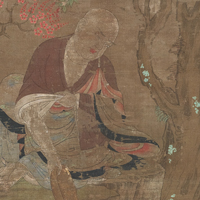The Arts of Buddhism | 8th–16th century
-

The Twelfth of the Sixteen Arhats, Heian period, 11th century (National Treasure)
Japanese Gallery (Honkan) Room 3
March 16, 2021 (Tue) - April 25, 2021 (Sun)The beliefs and arts of Buddhism, along with its followers, became more diverse over time. In the Heian period (794–1192), the emperor and court nobility practiced and supported Buddhism. They used their vast wealth to build temples and create images for worship, often in delicate styles reflecting their tastes.
In the Kamakura period (1192–1333), the samurai gained political power, also becoming patrons of Buddhism. They preferred Buddhist art that was clear and dynamic, which led artisans to develop new styles. Many common people also became followers of Buddhism at this time, blending this religion with local beliefs, especially in the Muromachi period (1392–1573).
During these centuries, monks brought new schools of Buddhist thought from China, and developed new schools in Japan based on older teachings. Buddhism also became more integrated with Shinto, the indigenous religion. The paintings, sculptures, ritual tools, and sacred calligraphy on display illustrate this diversity in Buddhism.
| Designation | Name | Creation/ Excavation/ Provenance |
Period | Acquisition/ Ownership/ Accession Number |
CMT | ||
| Highlight | Important Cultural Property | The Monk Yuiken | By Chōkei | Nanbokuchō period, 1372 (Ōan 5) | Lent by Hōkai-ji Temple, Kanagawa | ||
| The Taima Mandala (The Pure Land of the Buddha Amida) | Kamakura period, 14th century | A-6 | |||||
| Highlight | The Descent of the Buddha Amida with Divine Attendants | Kamakura period, 14th century | A-11974-2 | ||||
| Highlight | National Treasure | The Twelfth of the Sixteen Arhats | Heian period, 11th century | A-11085-4 | |||
| Highlight | Important Art Object | The Second of the Sixteen Arhats | Kamakura period, 14th century | Lent by Guhō-ji Temple, Chiba | |||
| Highlight | The Buddhist Monk Kūkai | Kamakura period, 14th century | A-11791 | ||||
| Highlight | Important Cultural Property | A Tale of "Tengu" (One of the Tō-ji Temple and Daigo-ji Temple Scrolls) | Kamakura period, 13th century | A-31-1 | |||
| Part of the "500 Disciples" Chapter of the "Lotus Sutra" with Each Character Encircled by a Pagoda (One of the “Uzumasa Fragments”) | Heian period, 12th century | B-1280 | |||||
| Highlight | Important Cultural Property | The Origins of Shitennō-ji Temple (Surviving Volume) | By Koremune Sueshige | Heian period, 1173 (Jōan 3) | Lent by Sanzen-in Temple, Kyoto | ||
| Highlight | National Treasure | Flower Basket with a Stylized Floral Motif ("Hōsōge") | Nanbokuchō period, 14th century | Lent by Jinshō-ji Temple, Shiga | |||
| Important Cultural Property | Basin for Bathing a Statue of the Infant Buddha | Heian period, 12th century | E-14286 | ||||
| Highlight | National Treasure | Gong ("Kei") with Lotus Vines | Heian period, 12th century | Lent by Zenrin-ji Temple, Kyoto |
